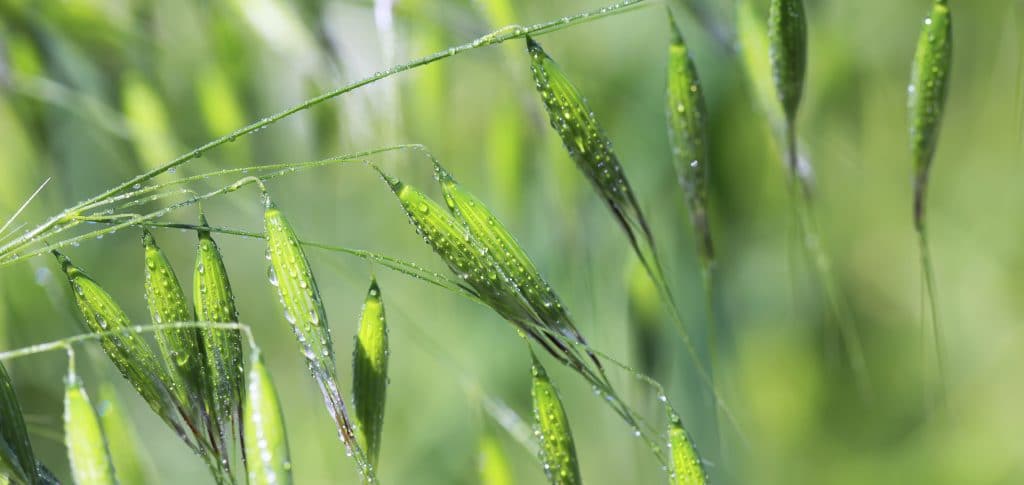6 Keys to Producing Food-Grade Oats
May 8, 2019
Not all oats are created equal. Grain Millers’ growth and success over the last 30+ years is
largely due to the support of our growers who provide us with the highest quality oats through the production of a food-grade oat crop.
Food-grade oats are grains that are destined to become an ingredient for human consumption. These oats need to be clean with plump, high test-weight kernels. It is important that we buy “an ingredient” and not a commodity.
Over the years we have been approached by numerous growers asking what they can do to produce food-grade oats. Grain Millers’ Crop Sciences team is dedicated to helping
farmers produce a crop of the greatest quality and quantity.
The information in this article contains the best tips from our Crop Sciences team and is designed to be used as a resource to help growers achieve these quality specifications and goals.
1. Variety & Field Selection
Varietal selection is one of the most important considerations when producing oats
destined for human consumption. The oats have several differing characteristics
including yield, lodging resistance, test weight, hull percentage, hull color,
maturity, and disease resistance.
There is not a certain oat variety that will be best for all situations. Environmental
factors including previous crops, disease problems, fertility, season length,
rainfall, temperature, and soil types play a significant role in determining
which oat variety will be best for the growing conditions.
In order to maximize yield and quality, some factors of the potential field selection must
be evaluated:
- Fields should be relatively free of wild oats and have minimal to no herbicide residue
carryover. - It is best practice to NOT rotate cereal grains back-to-back with oats.
- More desirable rotational crops include canola, hay fields, soybeans, and/or other legumes.
- Oats can tolerate cooler and wetter soils than many other crops and can germinate at soil temps
as low as 45°F or 7°C. Early planting will typically help provide a production edge later in the season.
2. Seeding
To ensure purity, germination, and overall quality, it is recommended to use certified seed. To provide defense against weeds and weather, oats should be seeded early. Weather is a significant factor to be aware of when planning the seeding process, considering oats can germinate in soil temps as low as 45°F or 7°C.
The recommended seeding rate for oats usually varies between 80 and 130 pounds per
acre, depending upon the amount of seeds per pound. The goal of this seeding rate is to have a final stand of 18-25 plants per square foot. It is important to calculate seeding rate in the method described below, because individual kernel size can vary greatly among varieties and crop years. Calculating seeding rate in this fashion can ensure you achieve optimal plant populations, which reduces tillering and improves both yield and quality. To accurately calculate seeding rate, use seeds per pound and the following formula:

3. Fertility & Weed Control
Although oats are a hardy crop, they require fewer nutrients than many other crops. Soil
tests are recommended to determine nutrient levels within the soil and accurately determine additional nutrient needs.
Organic and conventional systems share common weed control tactics:
- Early planting allows the crop to canopy and compete better with weeds.
- Oats are known to provide an allelopathic (the chemical inhibition of one plant acting as a germination or growth inhibitor) residue that hinders germination of many weeds.
- The seeding rate plays a factor in overall weed control. An adequate stand will help shade and create stronger competition against weeds.
- Conventional systems also allow for use of herbicides to help promote weed control. Be sure to only use approved herbicides and to always follow label directions for application.
4. Insects & Diseases
Monitoring disease pressure is just as important in oats as any other crop. A handful of
fungal diseases bring about the largest area for concern. Crown and Stem Rust,
Septoria, and Fusarium Head Blight are the most prominent. Within a conventional system, each of these fungal diseases can be treated with timely applications of fungicides. When in an organic system, control comes from genetic resistance increasing the importance of variety selection.
- Crown Rust: Symptoms of this fungal disease consist of red/orange colored pustules forming on the leaves of the oat plant. Fields should be scouted during the late 4 leaf stage and into flag leaf. Fungicide control for crown rust is most effective when applied during flag leaf.
- Septoria: A fungal disease that exhibits symptoms first as small spots on the lower leaves of seedlings. Spots grow into larger, lens-shaped lesions which are initially yellow and later turn reddish brown. Lesions are first found on lower leaves within the plant canopy. Wet, warm, and humid conditions promote growth. Fungicide applications have been known to help control spread and damage of the disease.
- Fusarium Head Blight: Fusarium Head Blight: Common symptoms are pink and tan shading at the base of an infected glume. This fungal disease is known to produce the mycotoxin deoxynivalenol (DON), more commonly known as vomitoxin. It is hard to scout for and detect within an oat crop. Fungicide application during flag leaf has been known to help reduce effects of FHB.
- BYDV: Also known as Red leaf, it is a virus that turns an infected leaf red or yellow and causes it to curl toward the midrib. The most common vector for BYDV is the Cherry Oat Aphid. BYDV is best controlled with genetic resistance variety selection. The newer varieties typically show resistance.
5. Maturity & Harvesting
Oats, unlike many other grains, mature from the top of the panicle downward. Since
90% of grain is in the bottom two-thirds of the head, it is important to ensure proper maturity before harvest.
- Swathing: Ideal grain moisture range is between 20-25%.
The greenest kernels should have just changed to a cream color. Swathing the
oats too early will have a negative effect on test weight and milling quality.
The oats should then dry to approximately 14% in the windrow before combining. - Straight Cutting: This should be done once the
oats have reached full maturity and the grain has dried to a moisture of
approximately 14-15%. Straight cutting may be done providing that adequate air-drying
is available prior to long term storage.
The desired moisture specification for delivery to Grain Millers’ facilities is
13.5%. If there is no on-farm capacity for bringing moisture down (aeration storage, grain dryer, etc.) then target harvest moisture should be 13.5% or less.
It is important to avoid de-hulled kernels when harvesting. If conditions are dry, widen concave and slow cylinder speeds to prevent de-hulling and kernel breakage. Perform reverse procedure if threshing quality is poor. Increasing fan speed will provide heavier test weights and higher quality milling oats.
6. Storage
Proper grain storage is imperative to maintain quality milling oats. Storage for oats
should be clean and dry; aeration is best if available. The target moisture should be between 11-13% when entering the bin for long-term storage.
If the oats are harvested above 14%, the proper use of a grain dryer is
recommended to bring down the moisture to an appropriate level. When drying
oats, the dryer should remain at a temperature of less than 160°F (70°C). Grain
temperature should not exceed 120°F (50°C) during the drying process. After
drying, the oats should be aerated in order to reduce the temperature for
greater quality preservation.
When moisture is below 14% at harvest, simple aeration will be able to bring down the moisture to storage levels. Be sure to only run fans on cool and dry days. As with all grain, oats should be closely monitored for hot spots or quality deterioration.
NEED ASSISTANCE?
If you have questions about producing food-grade oats, or any other grains, our Crop Sciences team is here to help. You are welcome to email us or call 952.983.1269.

